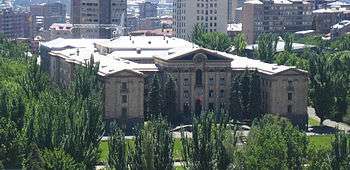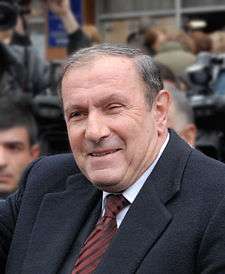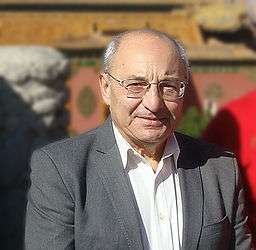1996 Armenian presidential election
Presidential elections were held in Armenia on 22 September 1996.[1] The result was a victory for Levon Ter-Petrosyan, who won 51.3% of the vote. Turnout was 60.3%.[2]
| |||||||||||||||||
| |||||||||||||||||
| |||||||||||||||||
Background
The 1996 presidential election was the second presidential election after Armenia's independence from the Soviet Union in 1991. On 18 September 1996, few days before the election, the influential Defence Minister Vazgen Sargsyan stated that he is "satisfied with the situation." Addressing Ter-Petrosyan's supporters, he proclaimed that Armenia "will enter the 21st century victoriously and stable with Ter-Petrosyan."[3] The opposition parties (Armenian Revolutionary Federation, Paruyr Hayrikyan's Union for National Self-Determination, Aram Sargsyan's Democratic Party) consolidated around the former Karabakh Committee member and former Prime Minister Vazgen Manukyan.[4]
Conduct
The observation and monitoring organizations were mostly critical of the conduct of the elections.[5][4][6][7][8] OSCE observation mission found "serious violations of the election law."[9]
Results
Following the elections, both Ter-Petrosyan and Manukyan claimed victory.[10] Official results by the Central Electoral Commission recorded Ter-Petrosyan's victory in the first round with just above 50% of the total vote in favor of the incumbent.[11]
| Candidate | Party | Votes | % |
|---|---|---|---|
| Levon Ter-Petrosyan | Pan-Armenian National Movement | 646,888 | 51.3 |
| Vazgen Manukyan | National Democratic Union | 516,129 | 41.0 |
| Sergey Badalyan | Armenian Communist Party | 79,347 | 6.3 |
| Ashot Manucharyan | Scientific-Industrial Civic Union | 7,529 | 0.6 |
| None of the above | 10,012 | 0.8 | |
| Invalid/blank votes | 48,681 | – | |
| Total | 1,308,548 | 100 | |
| Source: Nohlen et al. | |||
Analysis
Hrant Mikayelian, researcher at the Caucasus Institute, noted that in precincts where turnout was lower than 64% Manukyan received 49.6% of the votes, while Ter-Petrosyan received 41.1%. Mikayelian notes that while it is clear that widespread falsifications took place, it is impossible to say with certainty that Manukyan actually received over 50% of the votes in the first round.[12]
Protests and aftermath

Oppositional leader Vazgen Manukyan officially received 41% of the vote and denouncing them started mass demonstrations in the afternoon of 23 September claiming electoral fraud by Ter-Petrosyan's supporters. An estimated of 200,000 people gathered in Freedom Square to protest the election results.[13] On 25 September, the mass of 150,000 to 200,000 gathered in the same square. Manukyan led the demonstrators to Baghramyan Avenue, where the parliament building is located (the Electoral Commission was inside the building at the time). Later during the day, the protesters broke the fence surrounding the Armenian parliament and got into the building. They beat up the parliament speaker Babken Ararktsyan and vice-speaker Ara Sahakyan.[14] The security forces were brought into Yerevan to restore order. On the same day, Defence Minister Vazgen Sargsyan stated that "even if they [the opposition] win 100 percent of the votes, neither the Army nor the National Security and Interior Ministry would recognize such political leaders."[15] Sargsyan was later criticized by the West for such statement. Vazgen Sargsyan and Minister of National Security Serzh Sargsyan announced on the Public Television of Armenia that their respective agencies have prevented an attempted coup d'état.[14] The government sent tanks and troops to Yerevan to enforce the ban on rallies and demonstrations on 26 September 1996.[16] A number of opposition leaders were stripped of legal immunity.[16] Manukyan appealed to the Constitutional Court with the request for a new election, but it was rejected.[14]
Later developments
A few years after the election, Ter-Petrosyan's closest "power minister" Vano Siradeghyan claimed in an interview that Ter-Petrosyan fell into a three-month depression and that he wanted Vazgen Sargsyan and Siradeghyan to resign. According to him "the whole state apparatus was demoralized, paralyzed and no government was formed during [the ensuing] three months."[14] Despite these claims, in a February 1997 interview Ter-Petrosyan denied the rumors of the resignation of Vazgen Sargsyan stating that "rumors are the innocent thing–but in this case I think that they are extremely dangerous. I mean the resignation of Vazgen Sargsyan–scandals which–in my opinion–are not innocent. If it is misinformation–it is ill-intentioned misinformation." He accused the opposition led by Manukyan for being a power "for which political ambitions are more important than our army–the problem of Artsakh–the Armenian Cause–which they made their slogan." Ter-Petrosyan then accused the opposition in being irresponsible: "I don’t know the meaning of their existence–but [they] have made no positive contribution to the problem of Artsakh–be it certain individuals or political parties."[17]
Since 1995 until his resignation in February 1998, Ter-Petrosyan was being criticized for his alleged authoritarian rule.[18] History Professor Stephan H. Astourian of the University of California, Berkeley suggests that after crushing popular protest by "military force, legal recourse had been perverted, and a president had been elected fraudulently." Astourian claims that the elections "tarnished Ter-Petrosian's image, but the West did not dwell on the problem." as "a weak president has his uses." The West increased the pressure on the non-democratically elected president on the Karabakh issue. Astourian believes that "even more than his image in the West, it was the president's own self-image, his 'ego ideal,' that was tarnished."[14]
References
- Dieter Nohlen, Florian Grotz & Christof Hartmann (2001) Elections in Asia: A data handbook, Volume I, p329 ISBN 0-19-924958-X
- Nohlen et al., p336
- "1996 թվականի սեպտեմբեր [The September of 1996]". Azg Daily (in Armenian). 26 September 2002. Retrieved 7 April 2013.
- "Armenia: After the 1996 Presidential Elections". United Nations High Commissioner for Refugees. 1 March 1997. Retrieved 21 July 2016.
- Astourian, Stephan H. (2001). From Ter-Petrosian to Kocharian: Leadership Change in Armenia (PDF). University of California, Berkeley. p. 43. Archived from the original (PDF) on 20 June 2013. Retrieved 11 January 2013.CS1 maint: ref=harv (link)
- "Armenian Chief Is Winner". The New York Times. 30 September 1996. Retrieved 12 April 2013.
- Hughes, James R. (2002). Ethnicity and territory in the former Soviet Union: regions in conflict. London: Cass. p. 152. ISBN 9780714682105.CS1 maint: ref=harv (link)
- "Armenian Presidential Elections September 24, 1996 Final Report". Office for Democratic Institutions and Human Rights. Retrieved 11 April 2013.
- Columbus, Frank H. (1999). Central and Eastern Europe in transition. 3 (1999). Commack, NY: Nova Publishers. p. 107. ISBN 9781560726876.
- "Incumbent claims victory in Armenian elections". CNN. 23 September 1996. Retrieved 7 April 2013.
- "Armenians Cast Ballots in Presidential Election". The New York Times. 23 September 1996. Retrieved 12 April 2013.
- "Если бы выборы в Армении были честными? Альтернативный подсчет. 1990-е гг". kavkaz-uzel.eu (in Russian). 16 December 2018. Archived from the original on 29 June 2019.
- Astourian 2001, p. 44.
- Astourian 2001, p. 45.
- Human rights watch world report 1997: events of 1996. New York: Human Rights Watch. 1997. p. 198. ISBN 9781564322074.
- Jeffries, Ian (2003). The Caucasus and Central Asian Republics at the Turn of the Twenty-First Century: A guide to the economies in transition. New York: Routledge. p. 57. ISBN 9780203358474.
- "Ter Petrosyan Denies Defense Minister's Resignation Rumors". Asbarez. 20 February 1997. Retrieved 6 April 2013.
- Eastern Europe, Russia and Central Asia: 2003. Taylor & Francis. 2002. pp. 79–80. ISBN 9781857431377.
External links
- (in Armenian) Ի՞նչ տեղի ունեցավ 1996–ի սեպտեմբերի 25-ին

